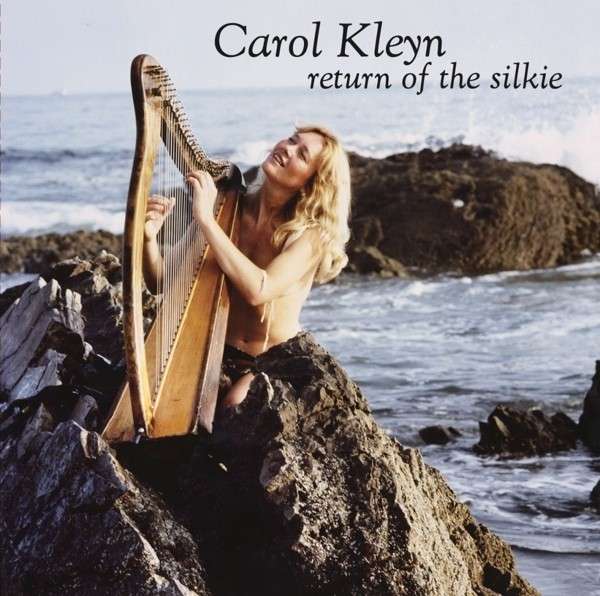We’re trained to mistrust earnestness – especially in music. This comes mostly from the fact that such earnestness oftentimes appears cloying and dishonest. And that it also might be a part of a larger heartstring strumming agenda that completely betrays the emotions which it strives so fervently to mimic. But sometimes a good heartstring pull is exactly what we need, as long as it’s done well. And harpist Carol Kleyn is there to accommodate us. Of course, if you’re not already familiar with her name, then you’re probably about 30 years too late. But no need to worry, venerable indie label Drag City has our best interests at heart, and with their re-issue of Kleyn’s 1983 record Return of the Silkie, the label is looking to make up for those misspent years.
Return of the Silkie is the third entry in an as-yet-unfinished musical saga which began in 1976 with Love Has Made Me Strongerand continued with 1980’s Takin’ The Time. Drag City re-issued these records back in 2011 and 2012, respectively. They form a detailed story of simple ideals, love, and a longed for freedom from mainstream industry – ideas she gleaned from her time studying at the University of California Santa Barbara in the late 60s. And it was here in college – in her freshman year – that she met psych/folk singer and “One Man Orchestra” Bobby Brown. The two became good friends (and eventually more than friends), and for her 21st birthday, he bought her a harp and she began to play. Her musical travels took her on a tour with Gregg Allmon, had her play a house party for Led Zeppelin (sans Jimmy Page), allowed her to be introduced to Frank Sinatra and Liza Minnelli, and included some awkward conversations with a young Cameron Crowe in the back of Allmon’s plane – for all intents and purposes, her life had the feel of Woody Allen’s Zelig, prior to that character’s narcissistic break.
But from a life well-lived, Kleyn has been able to extract her own optimistic and buoyant attitudes from this colorful history. And on Return of the Silkie, she carefully layers lyrics concerning love, the need to be free, and philosophies about simple living – and all this in a time when people had begun to drop the altruistic outlook that ran rampant in the 60s, and to a lesser degree in the 70s, and were turning toward a more self-seeking approach to life. But according to Kleyn, the main inspiration for Silkie came from her time nursing injured baby sea lions and elephant seals back to health at “the big red barn in Laguna Canyon.” She even went so far as to record their voices with her own and considered herself “not so unlike the pied piper of Hamlin.”
So Carol Kleyn is a harpist with the heart of a flower child and the indomitable optimism redolent of participants who found themselves entrenched within the “Summer of Love” attitude of the late 60s. But there is more to her and her music than can be gleaned on first listen. Granted, the majority of Return of the Silkie is composed and performed on harp and the main accompaniment is her strikingly otherworldly voice, but beneath this deceptively simple façade is a heart beating in time with the natural world around it. Her abject earnestness has been hard-won and feels as comforting as the notes which she plies so easily from the strings of her instrument. And while the album is constructed from individual tracks, it feels more like one continuous statement from Kleyn regarding the nature of her surroundings and an understanding of her place within it.
“Return of the Silkie” opens the album with subtle flourishes of found sound recordings and Kleyn’s haunting and ethereal vocalizing – add some loops and vocal effects and you’re nearing Julianna Barwick territory. There are no set lyrics but the intent is clear and the album feels set on its way by the pristine plucks and shimmering waves of her playing. While I’m not purposefully avoiding the Joanna Newsom comparisons, they are obviously there to be made – so you know, have at it. To further connect the ocean atmosphere to the music on the record, Kleyn uses recordings of the ocean tides to bridge each track with one another. There are times when a continuous sample of ocean noise spans multiple tracks but is only audible when the last musical notes fade out at the end of the songs. The brief barking of sea lions and seals can be heard intermittently broaching the music across a handful of tracks.
That’s not to say that the record is homogenous in a dull or unexciting way. The music hums with the life of its surroundings, with tracks like “Iaqua” and “Lorelai” being downright gorgeous, as tendrils of plucked notes weave themselves throughout her airy vocals. “Hello Mister Drifter” tells the story of someone who is merely passing through the world, having been to different places and having seen many things that other people can only dream of, while “Land Voyage” is a shorter instrumental piece that holds one of the album’s most memorable melodies and is over far too quickly. Others like “Storm Over Paradise” and album closer “And Back Again” feel cyclical, with Kleyn’s harp expressing a depth of emotion through a varied repetition of melody and structure. While you might expect the music to feel weightless and flighty, there is a grounded knowingness of the world to suggest that Kleyn knows more than she’s letting on. With an album so fraught with possibly misconstrued altruism and sincerity, maybe this straightforwardness itself can be seen as something analogous to the counter-culture ideals from which these songs so readily draw breath.

